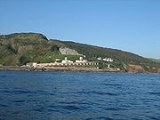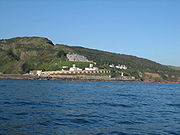
Fort Bovisand
Encyclopedia

Devon
Devon is a large county in southwestern England. The county is sometimes referred to as Devonshire, although the term is rarely used inside the county itself as the county has never been officially "shired", it often indicates a traditional or historical context.The county shares borders with...
, England
England
England is a country that is part of the United Kingdom. It shares land borders with Scotland to the north and Wales to the west; the Irish Sea is to the north west, the Celtic Sea to the south west, with the North Sea to the east and the English Channel to the south separating it from continental...
near the beach of Bovisand
Bovisand
Bovisand is a natural coastline on the east side of Plymouth Sound in Devon, England.Despite the steep cliff paths and rocky surrounding, Bovisand features two beaches, a holiday park, privately owned bungalows and a diving centre at Fort Bovisand...
. It was built on the mainland to defend the entrance of Plymouth Sound
Plymouth Sound
Plymouth Sound, or locally just The Sound, is a bay at Plymouth in England.Its southwest and southeast corners are Penlee Point in Cornwall and Wembury Point on Devon, a distance of about 3 nautical miles . Its northern limit is Plymouth Hoe giving a north-south distance of nearly 3 nautical miles...
, at the narrows opposite the east end of Plymouth Breakwater
Plymouth Breakwater
Plymouth Breakwater is a stone breakwater protecting Plymouth Sound and the anchorages therein. It is wide at the top and the base is . It lies in about of water. Around 4 million tons of rock were used in its construction in 1812 at the then-colossal cost of £1.5 million .-History:In 1806, as...
. The fort is beside Bovisand harbour.
History
In 1816 a stone jettyJetty
A jetty is any of a variety of structures used in river, dock, and maritime works that are generally carried out in pairs from river banks, or in continuation of river channels at their outlets into deep water; or out into docks, and outside their entrances; or for forming basins along the...
and slip
Slipway
A slipway, boat slip or just a slip, is a ramp on the shore by which ships or boats can be moved to and from the water. They are used for building and repairing ships and boats. They are also used for launching and retrieving small boats on trailers and flying boats on their undercarriage. The...
were built for boats from sailing warship
Warship
A warship is a ship that is built and primarily intended for combat. Warships are usually built in a completely different way from merchant ships. As well as being armed, warships are designed to withstand damage and are usually faster and more maneuvrable than merchant ships...
s anchored in Plymouth Sound to collect fresh water
Fresh Water
Fresh Water is the debut album by Australian rock and blues singer Alison McCallum, released in 1972. Rare for an Australian artist at the time, it came in a gatefold sleeve...
from the nearby reservoir. The first fort at the site, named Staddon Height Battery, was started in 1845, and still exists in the upper part of the present fort. As part of the recommendations of the Royal Commission on the Defence of the United Kingdom
Royal Commission on the Defence of the United Kingdom
In 1859 Lord Palmerston instigated the Royal Commission on the Defence of the United Kingdom because of serious concerns that France might attempt to invade the UK...
, work started on the main part of the fort consisting of 23 granite
Granite
Granite is a common and widely occurring type of intrusive, felsic, igneous rock. Granite usually has a medium- to coarse-grained texture. Occasionally some individual crystals are larger than the groundmass, in which case the texture is known as porphyritic. A granitic rock with a porphyritic...
casemate
Casemate
A casemate, sometimes rendered casement, is a fortified gun emplacement or armored structure from which guns are fired. originally a vaulted chamber in a fortress.-Origin of the term:...
s, originally housing 22 9-inch Rifled Muzzle Loader
RML 9 inch 12 ton gun
The RML 9 inch guns Mark I - Mark VI were large rifled muzzle-loading guns used as primary armament on smaller British ironclad battleships and secondary armament on larger battleships, and also ashore for coast defence.-Design:...
s (RMLs), one 10-inch RML
RML 10 inch 18 ton gun
The RML 10 inch guns Mk I - Mk II were large rifled muzzle-loading guns designed for British battleships and monitors. They were also fitted to the Bouncer-class flat-iron gunboats.-Design:...
gun and 180 men. By 1880 the armament included 14 10-inch and nine 9-inch RML guns. Underground there are large deep tunnels to store artillery ammunition safe from enemy gunfire. In 1898 six 12-pounder quick-firing guns
QF 12 pounder 12 cwt naval gun
The QF 12 pounder 12 cwt gun was a common calibre naval gun introduced in 1894 and used until the middle of the 20th century. It was produced by Armstrong Whitworth, Elswick and used on Royal Navy warships, and exported to allied countries...
were installed.
In the early 1900s the original guns were removed. In 1942 the remaining four 12-pounders were replaced by two twin 6-pounders
QF 6 pounder 10 cwt gun
The British QF 6 pounder 10 cwt gun"6 pounder" refers to approximate weight of projectiles, which was a traditional British way of denoting small guns. "10 cwt" referred to the approximate weight of the gun and breech in cwt rounded up : 10 cwt = 10 x 112 pounds = 1,120 pounds...
, to combat E-boat
E-boat
E-boats was the designation for Motor Torpedo Boats of the German Navy during World War II. It is commonly held that the E stood for Enemy....
s. A Bofors 40mm anti-aircraft gun was installed in 1943. In 1956 the Ministry of Defence
Ministry of Defence (United Kingdom)
The Ministry of Defence is the United Kingdom government department responsible for implementation of government defence policy and is the headquarters of the British Armed Forces....
abandoned the fort and a lease was granted in 1970.
Recent use
In the early 1970s the fort was converted into a national commercial divingCommercial Diving
Professional diving is a type of diving where the divers are paid for their work. There are several branches of professional diving, the most well known of which is probably commercial diving...
school and scuba diving
Scuba diving
Scuba diving is a form of underwater diving in which a diver uses a scuba set to breathe underwater....
centre. The fort at the top of the headland (above the coastal path) was used as a school's outdoor activity centre from about the mid 1970s to at least the early 1990s. The upper fort's magazine and various other buildings were converted to be used as basic bunk houses, kitchen and dining area. The cottage was used as a toilet and shower block and a lounge and staff accommodation.
By 2000 the main leaseholder Fort Bovisand Underwater Centre had liquidated
Liquidation
In law, liquidation is the process by which a company is brought to an end, and the assets and property of the company redistributed. Liquidation is also sometimes referred to as winding-up or dissolution, although dissolution technically refers to the last stage of liquidation...
, but other diving services continued trading. Months of argument continued about the status of the lease
Lease
A lease is a contractual arrangement calling for the lessee to pay the lessor for use of an asset. A rental agreement is a lease in which the asset is tangible property...
s and viability of existing businesses based there.
In December 2000 Marine Contractors Ltd (one of the main businesses based there, and one of the parties negotiating to take over the running of Fort Bovisand) went into receivership. As a result, the owners (the Ministry of Defence
Ministry of Defence (United Kingdom)
The Ministry of Defence is the United Kingdom government department responsible for implementation of government defence policy and is the headquarters of the British Armed Forces....
) decided it was no longer possible to keep the site functioning, and the remaining diving etc firms trading there ceased operations.
By mid-2005 ex-BBC
BBC
The British Broadcasting Corporation is a British public service broadcaster. Its headquarters is at Broadcasting House in the City of Westminster, London. It is the largest broadcaster in the world, with about 23,000 staff...
boss Greg Dyke
Greg Dyke
Gregory "Greg" Dyke is a British media executive, journalist and broadcaster. Since the 1960s, Dyke has a long career in the UK in print and then broadcast journalism. He is credited with introducing 'tabloid' television to British broadcasting, and reviving the ratings of TV-am...
and local property developer John Steven owned Fort Bovisand and had plans to set up a new business there.
In mid 2008 Fort Bovisand was home to Discovery Divers, which was set up in 2003.

